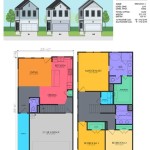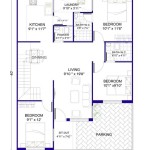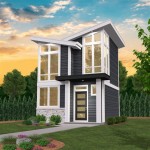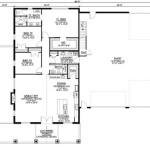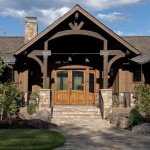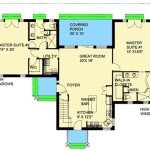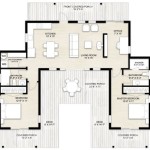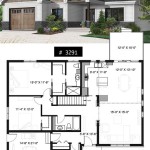Simple Single Floor House Plans: Efficiency and Comfort in One Level
The allure of simple single-floor house plans lies in their accessibility, ease of maintenance, and adaptability to various lifestyles. These plans, also known as ranch-style or single-story homes, provide a convenient and comfortable living experience by eliminating the need for stairs and consolidating all living spaces on one level. This article will explore the key benefits, design considerations, and practical aspects of simple single-floor house plans.
Accessibility and Universal Design
One of the most significant advantages of a single-floor house plan is its enhanced accessibility. The absence of stairs makes these homes ideal for individuals with mobility limitations, including the elderly, people with disabilities, and families with young children. This inherent accessibility allows for aging in place, meaning individuals can remain in their homes comfortably and safely throughout their lifespan without the need for costly modifications later on.
Universal design principles are often incorporated into single-floor house plans to further enhance accessibility. These principles focus on creating spaces that are usable by people of all abilities, regardless of age or physical condition. Examples of universal design features that are commonly found in single-floor homes include wider doorways and hallways that accommodate wheelchairs or walkers, curbless showers that eliminate tripping hazards, lever-style door handles that are easier to grip, and strategically placed grab bars in bathrooms.
Ramps can be subtly integrated into the design to provide seamless transitions between indoor and outdoor spaces. These ramps can be constructed with gentle slopes and non-slip surfaces to ensure safety and ease of access. Furthermore, adjustable-height countertops and sinks can be incorporated into the kitchen and bathrooms to cater to individuals with varying heights.
The ease of navigation within a single-floor home also contributes to a sense of independence and freedom for individuals with limited mobility. This can significantly improve their quality of life and reduce the need for assistance from caregivers. By prioritizing accessibility, single-floor house plans promote inclusivity and enable individuals to live comfortably and independently in their own homes.
Cost-Effectiveness and Simplified Maintenance
Single-floor house plans can often be more cost-effective to build than multi-story homes of similar square footage. This is primarily due to the simplified foundation requirements and the reduced need for complex structural elements. A single-story home requires less excavation, fewer load-bearing walls, and a simpler roof structure, all of which contribute to lower construction costs.
Furthermore, the absence of stairs reduces the overall construction time and labor costs. Staircases require specialized carpentry skills and can be time-consuming to build. Eliminating stairs streamlines the construction process and allows for quicker project completion.
Maintenance is also generally simpler and less expensive in a single-floor home. Routine tasks such as cleaning gutters, painting exterior walls, and repairing the roof are more easily accomplished without the need for ladders or scaffolding. This can save homeowners both time and money in the long run.
Additionally, heating and cooling efficiency can be improved in a single-floor home. With all living spaces on one level, it is easier to regulate the temperature and minimize energy waste. This can result in lower utility bills and a more comfortable living environment. Proper insulation and energy-efficient windows and doors can further enhance the energy efficiency of a single-floor home.
From a resale perspective, single-floor homes are often highly desirable, particularly among seniors and individuals with mobility limitations. This can make them a sound investment and increase their long-term value.
Design Flexibility and Adaptability
Single-floor house plans offer a wide range of design possibilities and can be adapted to suit various lifestyles and preferences. They can be designed in a variety of architectural styles, from traditional ranch homes to modern and contemporary designs. The layout can be customized to maximize space utilization and create a comfortable and functional living environment.
One popular design trend in single-floor homes is the open-concept layout. This involves combining the living room, dining room, and kitchen into one large, open space. This creates a sense of spaciousness and encourages interaction between family members and guests. Open-concept layouts are particularly well-suited for entertaining and can make a home feel more inviting and welcoming.
The design of a single-floor home can also be tailored to take advantage of natural light and outdoor views. Large windows and sliding glass doors can be incorporated to bring in ample natural light and create a connection to the surrounding landscape. Outdoor living spaces, such as patios and decks, can be seamlessly integrated into the design to extend the living area and provide opportunities for relaxation and entertainment.
Single-floor house plans can also be easily adapted to accommodate future needs. Adding an extra bedroom or bathroom, expanding the kitchen, or creating a home office can be done without the need for major structural modifications. This flexibility makes single-floor homes a practical choice for families who anticipate changes in their lifestyle or needs over time.
The footprint of a single-floor home can also be adjusted to fit the size and shape of the lot. Narrow lots can be accommodated with long, rectangular floor plans, while wider lots can accommodate more sprawling layouts. The orientation of the home can also be carefully considered to maximize sunlight exposure and energy efficiency.
Furthermore, the interior design of a single-floor home can be customized to reflect the homeowner's personal style and preferences. A wide range of materials, finishes, and color palettes can be used to create a unique and inviting living space.
Considerations for Choosing a Single-Floor House Plan
While offering numerous advantages, selecting a simple single-floor house plan also requires careful consideration. A primary factor is lot size and shape. Single-story homes typically require a larger footprint than multi-story homes of comparable square footage. Therefore, a sufficiently large lot is necessary to accommodate the desired floor plan. It is essential to evaluate local zoning regulations and setback requirements to ensure that the proposed building complies with all applicable rules.
Privacy is another crucial consideration, particularly in densely populated areas. Strategically positioning windows and landscaping can help to minimize noise and visual intrusion from neighbors. Fencing or hedges can also be used to create a more private and secluded outdoor living space.
The roof design can significantly impact the overall aesthetic and cost of a single-floor home. Low-pitched roofs are generally more affordable to construct, while steeper roofs can add visual interest and provide additional attic space for storage. The choice of roofing materials can also affect the durability and longevity of the roof.
Proper insulation is essential for maintaining a comfortable indoor climate and reducing energy costs. Insulating the walls, roof, and floors can help to minimize heat loss in the winter and heat gain in the summer. This can result in significant savings on utility bills over time.
Ventilation is also important for maintaining indoor air quality and preventing moisture buildup. Adequate ventilation can help to remove pollutants and allergens from the air, creating a healthier living environment. This can be achieved through natural ventilation (opening windows and doors) or mechanical ventilation (using fans or air exchangers).
Finally, it is essential to work with a qualified architect or designer who has experience in creating single-floor house plans. An experienced professional can help to navigate the design process, ensure that the plan meets the homeowner's needs and budget, and provide guidance on selecting appropriate materials and finishes.
In conclusion, simple single-floor house plans offer a compelling combination of accessibility, cost-effectiveness, design flexibility, and ease of maintenance. By carefully considering the factors outlined above, individuals can select a single-floor house plan that provides a comfortable, functional, and sustainable living environment for years to come. These plans can be molded to fit a variety of needs and preferences, making them an ideal choice for a diverse range of homeowners.

Of One Bedroom Single Story Residence In 60 M² Lot House Floor Plans Roof Design Small

Celebrity Group Lifestyle Dream Homes I Elevation Single Floor House Design Simple Independent

Cecile One Story Simple House Design Pinoy Plans

One Floor House Plans 90 Front Elevation Simple Designs Design Single

Single Floor House Plan Design Ideas Acha Homes

Of Simple Two Bedroom Single Floor House With 68 M² Area 2 Plans Design

15 Ways To Plan A Low Budget Single Floor House Design

300 Best Single Floor House Designs Modern Plans

Superb Single Floor Design Kerala House At 1070 Sq Ft

Single Story 1 Bedroom Deceptively Simple Contemporary House Plan

